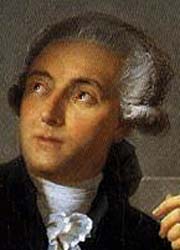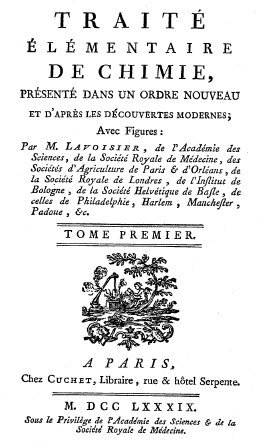1902 Encyclopedia > Chemistry > History of Chemistry: Antoine Laurent Lavoisier
HISTORY OF CHEMISTRY: Antoine Laurent Lavoisier (1743-94)
Although neither the science of chemistry nor yet a change in its objects can be said to have originated with Lavoisier (1743-1794), the means he introduced of attaining those objects, the ideas he put forth concerning the constitution of bodies, and the explanations he gave of various phenomena were new, and gave to the science in the twenty years preceding his death a completely altered aspect. The mine of chemistry had yielded rich returns long before Lavoisier came to labour in it; he availed himself of the old workings and, extending them opened the main lode. "He discovered," says Liebig, "no new body, no new property, no natural phenomenon previously unknown; but all the facts established by him were the necessary consequences of the labours of those who preceded him. His merit, his immortal glory consisted in this – that he infused into the body of the science a new spirit; but all the members of that body were already in existence, and rightly joined together." – (Letters on Chemistry, ii.) In the first of his papers, in 1765, Lavoisier indicates no doubt of the existence of phlogiston., In 1775 he still spoke of it, but in the following years he expressed his conviction that, for the elucidation of certain phenomena, one must ascribe to phlogiston other qualities than those assigned to it by Stahl. It was in 1775 that he presented to the French Academy a memoir On the Nature of the Principle which combines with the Metals during their Calcination, and which augments their Weight, in which he described the formation of fixed air from charcoal in the reduction of calces, and the preparation and properties of oxygen; but he makes no allusion to the fact that Priestley had in November of the foregoing year made him acquainted with that gas, or to the observations of Bayen in the Journal de Physique, February and April 1774, to the effect that the change of a metal into a calx is attributable to the fixation of an aerial fluid, and that the red oxide of mercury is reduced by heat without the addition of anything, and loses in weight by reduction.

Antoine Laurent Lavoisier (1743-94)
French chemist
In 1776 Lavoisier, by experiments with phosphorus and sulphur, confirmed results already arrived at by him—that the atmosphere contained two gases, azote or nitrogen, and a highly respirable air, the absorption of which by burning substances accounts for their increase in weight. In 1777 he combated the assertion of Priestley that air is rendered irrespirable by becoming loaded with phlogiston, and showed that air in which candles were burnt furnished about two fifths of its volume of fixed air, and that pure or dephlogisticated air under the same conditions became almost completely transformed into that gas. In a paper received by the Academy in 1778 Lavoisier broached his theory that the dephologisticated air of Priestley was the universal acidifying or oxygenizing principle, which by combination with charcoal, sulphur, nitrogen, and phosphorous formed carbonic, vitriolic, nitric, and phosphoric acids, and with metals, calces; all the phenomena of combustion, Lavoisier contended, were explicable without the supposition of the existence of phlogiston, of which there was no evidence. In 1783, when he had determined to discover by carefully conducted experiments the nature of the product of the combustion of hydrogen, Lavoisier learned that Cavendish had ascertained that body to be water. He therefore repeated Cavendish’s experiments, and with the aid of Meusnier proved that water contains hydrogen, by passing steam through a red-hot porcelain tube containing iron wire. Lavoisier has long phlogiston of metals, seeing that the calces were actually heavier than the metals supposed to contain them, and that the hydrogen supposed to be evolved by the metals, though light, certainly had weight. Lavoisier now explained the production of hydrogen during the solution of metals in acids on the assumption that water was decomposed, its oxygen uniting with the metals, whilst its hydrogen escaped. In the case, however, of nitric acid, oxygen was supposed to be supplied by the acid. The effect of Lavoisier’s reasonings upon his contemporaries is illustrated by Priestley’s remark (Phil. Trans., 1788, p. 155) that, "the doctrine of the decomposition of water being set aside, that of phlogiston (which in consequence of the late experiments on water has been almost universally abandoned) will much better stand its ground." But the fate of the Stahlian philosophy was sealed; and in 1792 Klaproth and the Berlin Academy gave in their adhesion to the new doctrines. Gren and Wiegleb in Germany, Delametherie in France, and Kirwan in England endeavoured but in vain, to support the phlogistic theory; and ere long Lavoisier’s innovations could be regarded not simply as the anti-phlogistic, but as universally accepted system of chemistry. "It was the glory of Lavoisier," wrote Davy in 1814, "to lay the foundation of a sound logic in chemistry by showing that the existence of this principle (phlogiston), or of other principles, should not be assumed where they could not be detected."

Title page of the first volume of the Traité élémentaire de Chimie
by A L Lavoisier
In 1789 was published Lavoisier’s Traité élémentaire de Chimie, in which the new chemical doctrines were set forth with remarkable clearness and ability. A list of 33 "simple substances" is given in the 2d part of the 1st vol. of this work, wherein light and caloric are included with oxygen, azote, and hydrogen as elements of bodies; but as to whether light was a modification of caloric, or caloric a modification of light, it was impossible. Lavoisier considered to decide (Traité élément., tom. 1. part ii. chap. 1). Under the head of "oxidable or acidifiable substances" he placed sulphur, phosphorus, carbon, and the muriatic, fluoric, and boracic radicals; the "oxidable and acidifiable metals" are antimony, silver, arsenic, bismuth, cobalt, copper, tin, iron, manganese, mercury, molybdenum, nickel, gold, platinum, lead, tungsten, and zinc; and the "simple earthy and salifiable substances" are line, magnesia, baryta, alumina, and silica. Of metallic oxides, he says (Traité étément., tom. i. part i. chap. vii.), ‘they ought not to be considered as completely saturated with oxygen, because their action on that principle is balanced by the force of attraction exercised upon it by caloric. Oxygen, then, in the calcination of metals, obeys really two forces – that exercised by the caloric and that exercised by the metal." Davy, who by his experiments on the effects of friction on ice did much to dispel the belief in the materiality of heat, but who regarded light as a body in a peculiar state of existence, and consisting of minute particles, held the view that light in phosoxygen (oxygen gas) was intimately combined with oxygen. – (Works, vol. ii. pp. 11-32).
The following table will serve to show the progress that has been made in the knowledge of the elementary bodies from the time of the publication of Lavoisier’s Traité élémentaire; the second and third columns give the authorities by whom and the dates when these bodies were either first isolated, or were recognized as simple substances: --
TABLE
Lavoisier was assisted in the establishment of his system by Fourcroy (1755-1809), Monge (1746-1818), Guyton de Morveau (1737-1816), and Berthollet (1748-1822); Lavoisier’s theory that oxygen was the principle of acidity was not, however, accepted by Berthollet. In 1803 appeared Berthollet’s Chemical Statics, in which Bergman’s conclusions with respect to the laws of the combination of acids and bases were disputed. Affinity, it was argued, could not be simply an attraction, for then no decomposition, but only an addition of constituents would take place when solutions of different compounds were mixed together; affinity might be regarded as an attraction between combining substances probably like that existing between the planetary bodies – an attraction dependent of mass, not on elective force, so that combination between the various kinds of matters could take place in all sorts of proportions. The complete removal of a constituent of a compound by means of a decomposing agent was attributed by Berthollet to its elasticity or insolubility in the free state, Thus, he considered that barium Sulphate was precipitated by solution of potassium sulphate because it was insoluble in water, but that a triple compound was formed when solutions of the sulphates of sodium and potassium were mingled. The decomposition a ammonium carbonate by sulphuric acid he asserted to be due to the elasticity of the carbonic acid gas that escaped. Berthollet’s hypotheses found on opponent in Proust (1755-1826), who had already written on the constancy of the relations by weight of the component parts of bodies, and had shown that tin and antimony unite with oxygen and iron with sulphur, in two definite proportions respectively. In a controversy with Berthollet that extended over some years he successfully demonstrated that all compounds are definite, and contain only certain determinate proportions of their constituents.
Related Pages: Life of Lavoisier
Read the rest of this article:
Chemistry - Table of Contents
|

